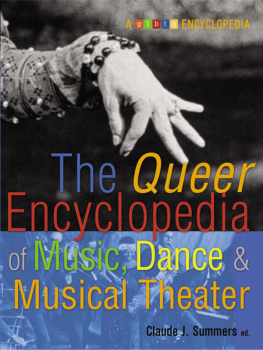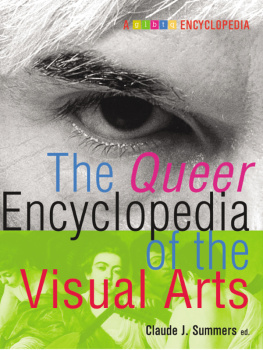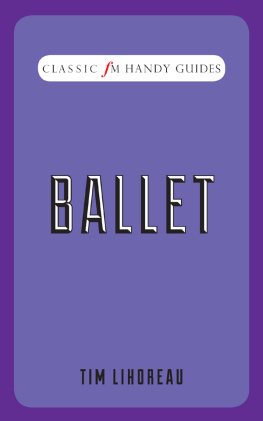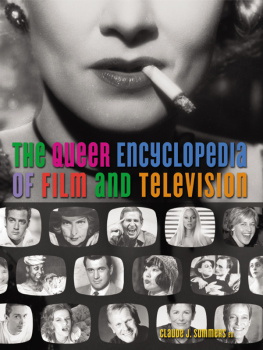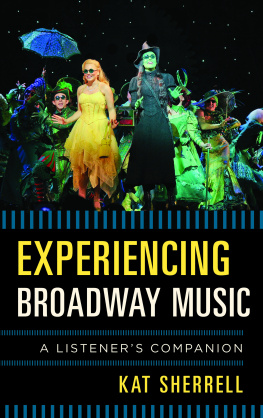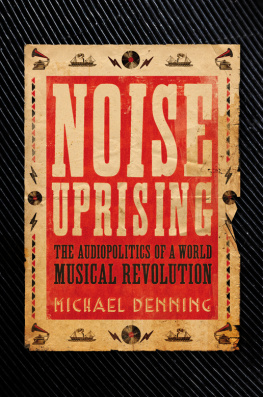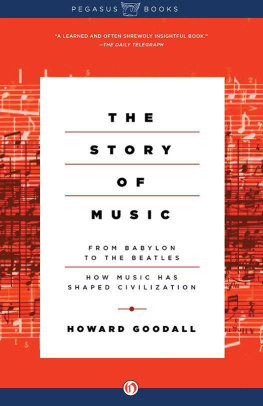The Queer Encyclopedia of Music, Dance & Musical Theater
Claude J. Summers
Editor

Copyright 2004 by glbtq, Inc.
All rights reserved. Except for brief passages quoted in newspaper, magazine, radio, or television reviews, no part of this book may be reproduced in any form or by any means, electronic or mechanical, including photocopying or recording, or by information storage or retrieval system, without permission in writing from the Publisher.
Published in the United States by Cleis Press Inc.,
P.O. Box 14697, San Francisco, California 94114.
Printed in the United States.
Cover design: Scott Idleman
Cover photograph: Vaslav Nijinski rehearsing "La Danse Siamoise" (from Les Orientales) taken Sunday, June 19, 1910, by Eugne Druet. Bibliothque Nationale de France.
Book design: Karen Quigg
Cleis Press logo art: Juana Alicia
First Edition.
10 9 8 7 6 5 4 3 2 1
Many organizations and individuals have been indispensable in providing access to the images that illustrate The Queer Encyclopedia of Music, Dance & Musical Theater. These deserve particular thanks. Blackheart Records for providing the image on page 135. Cleis Press for providing the images on pages 141 and 187. Clipart.com for providing the image on page 79 (Copyright 2002-2004, Clipart.com). Dreamworks Records for providing the image on page 282. Marc Geller for providing the image on page 222. Les Ballets Trockadero de Monte Carlo for providing the image on page 17. The Library of Congress Prints and Photographs Division for providing the images on pages 1, 4, 18, 25, 29, 92, 114, 117, 167, 168, 209, 214, 217, 227, 230, 237, 246, 253, 255, and 256. The Mark Morris Dance Group and Cleis Press for providing the image on page 177. Miller Wright and Associates, Inc. for providing the image on page 103. Holly Near for providing the image on page 186. NewsCom for providing the images on pages 68, 223, 241, and 267. NewsCom/INFGoff.com for providing the image on page 137. NewsCom/Notimex for providing the image on page 262. NewsCom/UPPA for providing the image on page 244. Northwestern University Library Art Collection for providing access to the image on page 144. The office of Tom Robinson for providing the image on page 218. Righteous Babe Records for providing the image on page 80. Rude Girl Publishing for providing the image on page 128. Sacks and Company for providing the image on 156. Snap/Zuma/NewsCom for providing the images on pages 108 and 159. Wolf Moon, Inc. for providing the image on page 274. Zuma Press/NewsCom for providing the image on page 162.
LIBRARY OF CONGRESS CATALOGING-IN-PUBLICATION DATA
The queer encyclopedia of music, dance, and musical theater / Claude J. Summers, editor.1st ed.
p. cm.
Includes bibliographical references and indexes.
ISBN 1-57344-198-8 (pbk. : alk. paper)
1. Homosexuality and musicEncyclopedias. 2. Homosexuality and danceEncyclopedias. 3. MusicEncyclopedias. 4. DanceEncyclopedias. 5. MusicalsEncyclopedias. I. Summers, Claude J.
ML100.Q44 2004
791'.08664'03dc22
2004021689
eISBN: 978-1-57344-875-8
For Ted, again;
and for Wik, the "onlie begetter,"
and for Albert Carey and George Koschel
ACKNOWLEDGMENTS
A collaborative project of the scope of The Queer Encyclopedia of Music, Dance & Musical Theater necessarily depends on the kindness and cooperation of numerous individuals, including especially the authors of the articles.
I owe most to Andrew "Wik" Wikholm, President of glbtq, Inc., whose vision and commitment and enthusiasm have made this book possible. Ted-Larry Pebworth has been a supportive partner and collaborator in many ways beyond the indexing and copyediting skills that he has deployed in this project. Linda Rapp, friend and assistant, has generously contributed her time, energy, and expertise.
I am grateful to all those who offered advice and made suggestions, especially as to topics and contributors. Patricia Juliana Smith and Thomas Riis have been especially helpful as members of the www.glbtq.com advisory board, as was Douglas Turnbaugh. Michael Tanimura, production manager at glbtq, discovered a number of inconsistencies and errors and knew how to correct them. Betsy Greco, glbtq project administrator, has been unfailingly efficient and cheerful. The sharp-eyed and informed editorial staff at Cleis Press has been a joy to work with. I am especially grateful to Mark Rhynsburger.
Work on this project has been sustained by the support of numerous friends, including Albert Carey, Raymond Frontain, Robert Herndon, and George Koschel.
Introduction
THE QUEER ENCYCLOPEDIA OF MUSIC, DANCE & Musical Theater introduces a remarkably rich cultural achievement. It surveys the contributions of gay, lesbian, bisexual, transgender, and queer people to popular and classical music, modern dance and ballet, and musical theater and opera, and also their representation in and sometimes vexed relationship to these varied arts. That is, this work is interested in glbtq individuals not only as composers, choreographers, lyricists, and performers, but also as subjects and objects and consumers of music, dance, and musical theater.
Presenting some 170 articles on individuals, artistic movements, musical genres, and topics such as Music and AIDS, Women's Music, and Cabarets and Revues, The Queer Encyclopedia of Music, Dance & MusicalTheater offers a revisionist history of these arts by seeing them through a queer lens. It places the achievements of gay, lesbian, bisexual, transgender, and queer composers, musicians, and performers in historical contexts and privileges the representation of subjects that have traditionally been censored or marginalized.
Celebrating the richness and variety of queer contributions to the musical arts, this book presents that achievement as an invaluable cultural legacy to be celebrated and treasured. This legacy includes accomplishments as diverse as the protean and transforming vision of Sergei Diaghilev and the iconoclasm of John Cage; the contributions of composers as different but equally seminal as George Frideric Handel, Cole Porter, and Billy Strayhorn; the vital work of blues artists as redoubtable as "Ma" Rainey and Bessie Smith; the accomplishments of performers as distinct as Joan Baez, Ray Bourbon, Liberace, Janis Joplin, Peter Pears, Charles Pierce, and the Indigo Girls; and the community-building efforts of gay and lesbian choruses and bands and women's music festivals.
It would be hard to imagine twentieth-century classical music without the presence of such gay or bisexual composers as Aaron Copland, Samuel Barber, Leonard Bernstein, Benjamin Britten, Manuel de Falla, or Karol Szymanowski, or to appreciate opera without understanding the phenomena of castrati, opera queens, and diva worship. But glbtq performers and composers have also influenced musical genres as apparently "nongay" as hard rock and even as reputedly "antigay" as jazz and country music, even as they have also pioneered in creating genres particularly associated with modern lesbian and gay culture, such as women's music, drag performance, and disco and dance music. Moreover, certain performersJudy Garland, Mabel Mercer, and Chavela Vargas, for exampleand certain genresopera and musical theater, most obviouslyhave had a particular resonance with glbtq audiences.
The queer presence in the musical arts is so various and pervasive that it resists neat summary. Indeed, it is an integral part of humanity's artistic expression, and as diverse as humanity itself. It can scarcely be divorced from "mainstream music and dance," for so many of the world's most prominent composers, choreographers, and performers have in fact been of alternative sexualities. One could not write a history of world music and dance without acknowledging the pivotal contributions of individuals whose sexual interests or gender expression varied from the orthodox (though, of course, many histories have been written that suppress the sexualities of those individuals).

